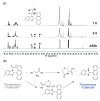Development of a Novel Benzimidazole-Based Probe and Portable Fluorimeter for the Detection of Cysteine in Human Urine
- PMID: 34821635
- PMCID: PMC8615561
- DOI: 10.3390/bios11110420
Development of a Novel Benzimidazole-Based Probe and Portable Fluorimeter for the Detection of Cysteine in Human Urine
Abstract
The measurement of cysteine in human urine and live cells is crucial for evaluating biological metabolism, monitoring and maintaining the immune system, preventing tissue/DNA damage caused by free radicals, preventing autoimmune diseases, and diagnosing disorders such as cystinuria and cancer. A method that uses a fluorescence turn-on probe and a portable fluorescence spectrometer device are crucial for highly sensitive, simple, rapid, and inexpensive cysteine detection. Herein, we present the synthesis and application of a benzimidazole-based fluorescent probe (ABIA) along with the design and development of a portable fluorescence spectrometer device (CysDDev) for detecting cysteine in simulated human urine. ABIA showed excellent selectivity and sensitivity in detecting cysteine over homocysteine, glutathione, and other amino acids with the response time of 1 min and demonstrated a detection limit of 16.3 nM using the developed CysDDev. Further, ABIA also demonstrated its utility in detecting intracellular cysteine, making it an excellent probe for bio-imaging assay.
Keywords: bio-imaging; biothiols; cancer; cysteine; cystinuria; fluorimeter; portable.
Conflict of interest statement
The authors declare no conflict of interest.
Figures








Similar articles
-
A colorimetric and fluorescent probe for detecting intracellular biothiols.Biosens Bioelectron. 2016 Nov 15;85:46-52. doi: 10.1016/j.bios.2016.04.098. Epub 2016 Apr 30. Biosens Bioelectron. 2016. PMID: 27155115
-
A novel turn-on type AIE fluorescent probe for highly selective detection of cysteine/homocysteine and its application in living cells.Talanta. 2022 Mar 1;239:123091. doi: 10.1016/j.talanta.2021.123091. Epub 2021 Nov 23. Talanta. 2022. PMID: 34861486
-
Elimination Reaction-Based Benzimidazole Probe for Cysteine Detection and Its Application in Serum Sample Analysis.Biosensors (Basel). 2022 Apr 8;12(4):224. doi: 10.3390/bios12040224. Biosensors (Basel). 2022. PMID: 35448284 Free PMC article.
-
A simple highly selective probe for discriminative visualization of endogenous cysteine, homocysteine and glutathione in living cells via three separated fluorescence channels.Talanta. 2020 Nov 1;219:121353. doi: 10.1016/j.talanta.2020.121353. Epub 2020 Jul 8. Talanta. 2020. PMID: 32887079
-
Recent Progress in the Rational Design of Biothiol-Responsive Fluorescent Probes.Molecules. 2023 May 22;28(10):4252. doi: 10.3390/molecules28104252. Molecules. 2023. PMID: 37241992 Free PMC article. Review.
Cited by
-
Microfluidic Sliding Paper-Based Device for Point-of-Care Determination of Albumin-to-Creatine Ratio in Human Urine.Biosensors (Basel). 2022 Jul 7;12(7):496. doi: 10.3390/bios12070496. Biosensors (Basel). 2022. PMID: 35884299 Free PMC article.
-
A Flexible Optoelectronic Device for Continuous Cerebral Blood Flow Monitoring.Biosensors (Basel). 2022 Oct 31;12(11):944. doi: 10.3390/bios12110944. Biosensors (Basel). 2022. PMID: 36354453 Free PMC article.
References
-
- Yu L., Teoh S.T., Ensink E., Ogrodzinski M.P., Yang C., Vazquez A.I., Lunt S.Y. Cysteine catabolism and the serine biosynthesis pathway support pyruvate production during pyruvate kinase knockdown in pancreatic cancer cells. Cancer Metab. 2019;7:13. doi: 10.1186/s40170-019-0205-z. - DOI - PMC - PubMed
MeSH terms
Substances
Grants and funding
LinkOut - more resources
Full Text Sources

